
The Olduvai Gorge or Oldupai Gorge in Tanzania is one of the most important paleoanthropological localities in the world; the many sites exposed by the gorge have proven invaluable in furthering understanding of early human evolution. A steep-sided ravine in the Great Rift Valley that stretches across East Africa, it is about 48 km long, and is located in the eastern Serengeti Plains within the Ngorongoro Conservation Area in the Olbalbal ward located in Ngorongoro District of Arusha Region, about 45 kilometres from Laetoli, another important archaeological locality of early human occupation. The British/Kenyan paleoanthropologist-archeologist team of Mary and Louis Leakey established excavation and research programs at Olduvai Gorge that achieved great advances in human knowledge. The site is registered as one of the National Historic Sites of Tanzania.

The Oldowan was a widespread stone tool archaeological industry (style) in prehistory. These early tools were simple, usually made by chipping one, or a few, flakes off a stone using another stone. Oldowan tools were used during the Lower Paleolithic period, 2.9 million years ago up until at least 1.7 million years ago (Ma), by ancient Hominins across much of Africa. This technological industry was followed by the more sophisticated Acheulean industry.

Homo antecessor is an extinct species of archaic human recorded in the Spanish Sierra de Atapuerca, a productive archaeological site, from 1.2 to 0.8 million years ago during the Early Pleistocene. Populations of this species may have been present elsewhere in Western Europe, and were among the first to settle that region of the world, hence the name. The first fossils were found in the Gran Dolina cave in 1994, and the species was formally described in 1997 as the last common ancestor of modern humans and Neanderthals, supplanting the more conventional H. heidelbergensis in this position. H. antecessor has since been reinterpreted as an offshoot from the modern human line, although probably one branching off just before the modern human/Neanderthal split.
The Atapuerca Mountains is a karstic hill formation near the village of Atapuerca in the province of Burgos, northern Spain.

Australopithecus garhi is a species of australopithecine from the Bouri Formation in the Afar Region of Ethiopia 2.6–2.5 million years ago (mya) during the Early Pleistocene. The first remains were described in 1999 based on several skeletal elements uncovered in the three years preceding. A. garhi was originally considered to have been a direct ancestor to Homo and the human line, but is now thought to have been an offshoot. Like other australopithecines, A. garhi had a brain volume of 450 cc (27 cu in); a jaw which jutted out (prognathism); relatively large molars and premolars; adaptations for both walking on two legs (bipedalism) and grasping while climbing (arboreality); and it is possible that, though unclear if, males were larger than females. One individual, presumed female based on size, may have been 140 cm tall.

The Argaric culture, named from the type site El Argar near the town of Antas, in what is now the province of Almería in southeastern Spain, is an Early Bronze Age culture which flourished between c. 2200 BC and 1550 BC.

Megantereon is an extinct genus of prehistoric machairodontine saber-toothed cat that lived in Eurasia, Africa and possibly North America from the late Pliocene to the Middle Pleistocene. It is a member of the tribe Smilodontini, and closely related to and possibly the ancestor of the famous American sabertooth Smilodon. In comparison to Smilodon it was somewhat smaller, around the size of a jaguar, though it is thought to have had a similar hunting strategy as an ambush predator.

Mammuthus meridionalis, sometimes called the southern mammoth, is an extinct species of mammoth native to Eurasia, including Europe, during the Early Pleistocene, living from around 2.5 million years ago to 800,000 years ago.
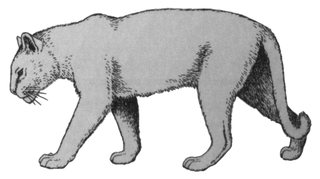
Panthera gombaszoegensis, also known as the European jaguar, is a Panthera species that lived from about 2.0 to 0.35 million years ago in Europe, as well as likely elsewhere in Eurasia. The first fossils were excavated in 1938 in Gombasek Cave, Slovakia. P. gombaszoegensis was a medium-large sized species that formed an important part of the European carnivore guild for a period of over a million years. Many authors have posited that it is the ancestor of the American jaguar, with some authors considering it the subspecies Panthera onca gombaszoegensis, though the close relationship between the two species has been questioned by some authors.

Hippopotamus antiquus is an extinct species of the genus Hippopotamus that ranged across Europe during the Early and Middle Pleistocene. It was considerably larger than the living hippopotamus.
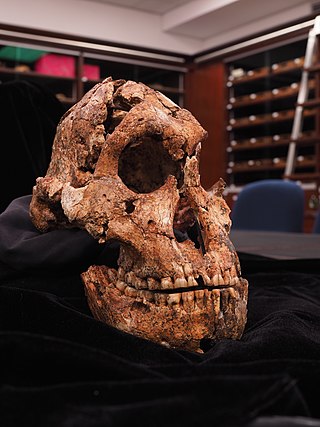
The Drimolen Palaeocave System consists of a series of terminal Pliocene to early Pleistocene hominin-bearing palaeocave fills located around 40 kilometres (25 mi) north of Johannesburg, South Africa, and about 6 kilometres (3.7 mi) north of Sterkfontein in the UNESCO World Heritage Site Cradle of Humankind.
Grotte du Vallonnet is an archaeological site located near Roquebrune-Cap-Martin, between Monaco and Menton, in France, that was first discovered in 1958. Stone tools found at the site have been dated to between 1 and 1.05 million years old, making it one of the earliest sites of human settlement known in Europe.
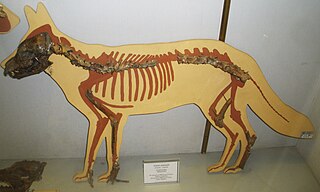
Canis arnensis, is an extinct species of canine that was endemic to Mediterranean Europe during the Early Pleistocene. Canis arnensis has been described as a small jackal-like canid. Its anatomy and morphology relate it more to the modern golden jackal than to the larger Etruscan wolf of that time. It is probably the ancestor of modern jackals.
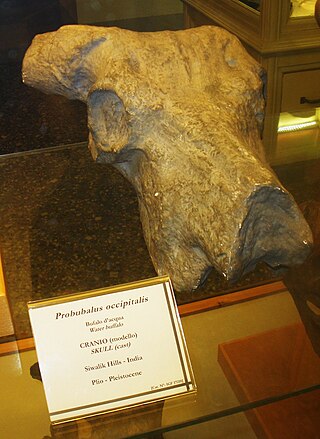
Hemibos is an extinct even-toed ungulate, belonging to the family Bovidae. Its fossil remains were found across Asia and Europe, including findings from China, the Italian Peninsula, the Iberian Peninsula, the State of Palestine, Israel, Pakistan, and India.
Shangchen is a Lower Palaeolithic archaeological site in Lantian County, Shaanxi, China, some 25 km south of Weinan. It was discovered in 1964, and excavated during 2004 and 2017.
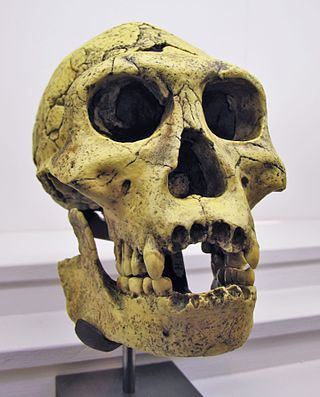
The Dmanisi hominins, Dmanisi people, or Dmanisi man were a population of Early Pleistocene hominins whose fossils have been recovered at Dmanisi, Georgia. The fossils and stone tools recovered at Dmanisi range in age from 1.85 to 1.77 million years old, making the Dmanisi hominins the earliest well-dated hominin fossils in Eurasia and the best preserved fossils of early Homo from a single site so early in time, though earlier fossils and artifacts have been found in Asia. Though their precise classification is controversial and disputed, the Dmanisi fossils are highly significant within research on early hominin migrations out of Africa. The Dmanisi hominins are known from over a hundred postcranial fossils and five famous well-preserved skulls, referred to as Dmanisi Skulls 1–5.

The archaeological site of Atapuerca is located in the province of Burgos in the north of Spain and is notable for its evidence of early human occupation. Bone fragments from around 800,000 years ago, found in its Gran Dolina cavern, provide the oldest known evidence of hominid settlement in Western Europe and of hominid cannibalism anywhere in the world.

Barranco León is an archaeological site in Orce, Andalusia, Spain with an age range between 1.2 and 1.4 million of years. It is noted for having yielded evidence of hominin occupation, including the milk tooth of a boy or girl of 10 years. After the tooth had been dated, its original owner was hailed as having left the earliest anatomical evidence for humans in Western Europe.

The Orce Man, Orce Donkey, or Venta Micena fossil is a fossil cranium fragment that was historically considered an infantile early European member of Homo. However, later researched suggested that the remains actually belonged to the equine species Equus altidens.
Equus altidens is an extinct species of equine native to western Eurasia including Europe during the Early Pleistocene to early Middle Pleistocene.

















